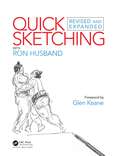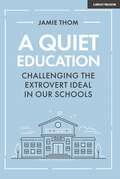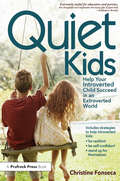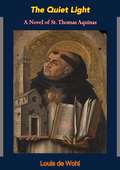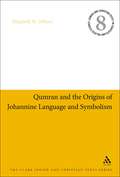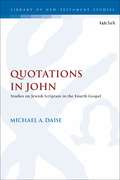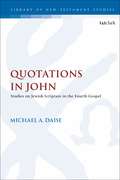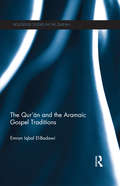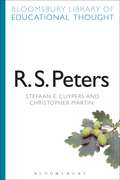- Table View
- List View
The Quick-Reference Handbook for School Leaders (PDF)
by National Association of Head Teachers'It's the type of useful self-help text that promises practical and easy-to-read guidance to help you manoeuvre round the enquiries and problems that litter your school's otherwise smooth journey to an A· judgement from Ofsted inspectors!' - Ldr 'This is a handbook to have available as a first source to consult when an issue first arises. It combines legal advice, information, suggested activities and a series of tips from headteachers who have dealt with such issues before. New headteachers in particular would be well-advised to read the section on media interviews before they are rushed into statements they later regret. 'Looking after Yourself' is a section that leaders would be well-advised to skim through periodically as a reminder as it is the kind of advice that gets forgotten in the hurly-burly of school life' - Brian Fidler Professor of Education Management, University of Reading Distilled from years of NAHT (National Association of Head Teachers) experience of providing advice and guidance for its members in the UK, The Quick-Reference Handbook for School Leaders is a practical guide that provides an answer to the questions "Where do I start?" and "Where do I look for direction?" Written in an easy-to-read, bulleted format, the handbook is organised around key sections, each part includes brief overviews, checklists and suggestions for further reading. o Organisation and Management - the role of the Headteacher, negligence and liability, media relations, managing conflict and difficult people, effective meetings, inspection, resource management, records and information. o Teaching and Learning - curriculum, learning communities, special education, evaluation, staff development, unions, celebrating success. o Behaviour and Discipline - safe schools, code of conduct, exclusion, search and seizure, police protocols. o Health and Safety - child protection issues, occupational health & safety, risk assessments, emergency preparation, medical needs, health & safety resources. o Looking After Yourself - continuing professional development, and work-life balance. This handbook is an excellent resource for all current and aspiring senior school leaders.
Quick Sketching
by Carl Cheek"Quick sketching" stimulates the artist's ability to rapidly capture a subject's features, expressions, and movements as they are actually happening. A perfect introduction to this invaluable technique, this concise and uniquely organized guide easily helps artists of every capacity explore new ideas and methods for creating powerful, true-to-life works of art.Discover over one hundred masterfully drawn sketches that wonderfully illustrate the accompanying text. An effective path to acquiring the artistic essentials of the human figure and countenance, as well as busy backgrounds, Quick Sketching offers up innovative, workable methods for quickly--and beautifully--drawing: * adults* children * animals * interiors * portraits * landscapes . . . and more!Affordably priced and sure to be viewed and reviewed again and again, Quick Sketching is a worthy addition to the library of every artist!
Quick Sketching with Ron Husband: Revised and Expanded
by Ron HusbandQuick Sketching with Ron Husband offers instruction to quick sketching and all its techniques. From observing positive and negative space and learning to recognize simple shapes in complex forms to action analysis and using line of action, this Disney legend teaches you how to sketch using all these components, and how to do it in a matter of seconds. Watch his drawings as he grows from a young, talented artist, to a true Disney animator. Follow him as he goes around the world and sketches flamenco dancers, football players, bakers, joggers, lions, tigers, anyone, and anything. Key Features Get tips on quick sketching from a Disney legend who has animated or supervised some of your favourite recent Disney movies like The Fox and the Hound, The Little Mermaid, and Beauty and the Beast. Features artist’s guide and handbook which provides instruction while chronicling the author’s growth as an artist. Quickly try out Husband’s instructions and tips as you learn them in a sketchbook at the back of the book. This new edition re-emphasizes the four basic shapes and how important it is to recognize them in fast action. Stressing the importance of observation and the vital part this discipline plays in sketching.
Quick Sketching with Ron Husband: Revised and Expanded
by Ron HusbandQuick Sketching with Ron Husband offers instruction to quick sketching and all its techniques. From observing positive and negative space and learning to recognize simple shapes in complex forms to action analysis and using line of action, this Disney legend teaches you how to sketch using all these components, and how to do it in a matter of seconds. Watch his drawings as he grows from a young, talented artist, to a true Disney animator. Follow him as he goes around the world and sketches flamenco dancers, football players, bakers, joggers, lions, tigers, anyone, and anything. Key Features Get tips on quick sketching from a Disney legend who has animated or supervised some of your favourite recent Disney movies like The Fox and the Hound, The Little Mermaid, and Beauty and the Beast. Features artist’s guide and handbook which provides instruction while chronicling the author’s growth as an artist. Quickly try out Husband’s instructions and tips as you learn them in a sketchbook at the back of the book. This new edition re-emphasizes the four basic shapes and how important it is to recognize them in fast action. Stressing the importance of observation and the vital part this discipline plays in sketching.
The Quiet Child
by Janet CollinsThis text focuses on the educational behaviour of the quiet child, including a range of case studies in which pupils reveal how their relationships with their parents influences their perception of themselves and their school life. The book is designed to help teachers understand the difference between shyness and severe withdrawal, and offers helpful advice on how best to meet the needs of quiet pupils. The result of considerable research, this book should help teachers identify teaching strategies for these pupils.
A Quiet Education: Challenging the extrovert ideal in our schools
by Jamie Thom'A Quiet Education' serves as an unashamed cheerleader for all that is quiet, challenging the myth that collaboration and noise should be at the heart of what happens in schools. It examines how we can ensure more introverted students and teachers can thrive and achieve their potential. It also explores why it is essential that all teachers begin to embrace quieter values: in their classrooms and management of behaviour; in sustaining their own wellbeing; in their desire to reflect meaningfully and improve as a teacher. The final section is an exploration of quieter skills: how we can strengthen our students' metacognitive ability; their ability to listen, pay attention and focus; the quality of independent work we do in the classroom alongside how we can motivate all our students.
Quiet Kids: Help Your Introverted Child Succeed in an Extroverted World
by Christine FonsecaBeing an introverted child is difficult, especially in an ever-increasingly noisy world. Often viewed as aloof, unmotivated, or conceited, introverted children are deeply misunderstood by parents, educators, and even their peers. That's where Quiet Kids: Help Your Introverted Child Succeed in an Extroverted World comes in. Designed to provide parents with a blueprint for understanding the nature of introversion, Quiet Kids provides specific strategies to teach children how to thrive in a world that may not understand them. Presented in an easy-to-read, conversational style, the book uses real-world examples and stories from introverts and parents to show parents and educators how to help children develop resiliency and enhance the positive qualities of being an introvert. With specific strategies to address academic performance, bullying, and resiliency, Quiet Kids is a must-read for anyone wishing to enhance the lives of introverted children.
Quiet Kids: Help Your Introverted Child Succeed in an Extroverted World
by Christine FonsecaBeing an introverted child is difficult, especially in an ever-increasingly noisy world. Often viewed as aloof, unmotivated, or conceited, introverted children are deeply misunderstood by parents, educators, and even their peers. That's where Quiet Kids: Help Your Introverted Child Succeed in an Extroverted World comes in. Designed to provide parents with a blueprint for understanding the nature of introversion, Quiet Kids provides specific strategies to teach children how to thrive in a world that may not understand them. Presented in an easy-to-read, conversational style, the book uses real-world examples and stories from introverts and parents to show parents and educators how to help children develop resiliency and enhance the positive qualities of being an introvert. With specific strategies to address academic performance, bullying, and resiliency, Quiet Kids is a must-read for anyone wishing to enhance the lives of introverted children.
The Quiet Light: A Novel of St. Thomas Aquinas
by Louis WohlThe famous novelist Louis de Wohl presents a stimulating historical novel about the great St. Thomas Aquinas, set against the violent background of the Italy of the Crusades. He tells the intriguing story of St. Thomas who—by taking a vow of poverty and joining the Dominicans—defied his illustrious, prominent family’s ambition for him to have great power in the Church.The battles and Crusades of the 13th century and the ruthlessness of the excommunicated Emperor Frederick II play a big part in the story, but it is Thomas of Aquino who dominates this book. De Wohl succeeds notably in portraying the exceptional quality of this man, a fusion of mighty intellect and childlike simplicity. A pupil of St. Albert the Great, the humble Thomas—through an intense life of study, writing, prayer, preaching and contemplation—ironically rose to become the influential figure of his age, and he later was proclaimed by the Church as the Angelic Doctor.As in all of his novels about great saints of the church, Louis de Wohl weaves an intricate colorful tapestry of love, violence and piety to bring to life a tremendous historical figure and the fascinating period in which he lived.Louis de Wohl was a distinguished and internationally respected Catholic writer whose books on saints have been best-sellers worldwide. Other available titles include Lay Siege to Heaven, Set All Afire and Citadel of God. Sixteen of his books were made into films.
Qumran and the Origins of Johannine Language and Symbolism (Jewish and Christian Texts)
by Elizabeth W. MburuThis work sets out to demonstrate that the sectarian Qumran document The Rule of the Community, provides linguistic clues which illuminate our understanding of how the author of the Fourth Gospel used truth terminology and expected it to be understood. It establishes that there are significant linguistic similarities shared by these two corpora. While these may be attributed to a development of the common tradition shared by both, as well as the influence ideology, the semantic continuity with the Rule of the Community makes it likely that the author of the Fourth Gospel was familiar with the mode of thought represented in the linguistic matrix of the Qumran literature and that he followed this in articulating his ideas in certain parts of his Gospel.
Qumran between the Old and New Testaments (The Library of Hebrew Bible/Old Testament Studies)
by Frederick H. Cryer Thomas L. ThompsonPapers from the International Scandinavian Conference on the Dead Sea Scrolls and Qumran, sponsored by the University of Copenhagen and held in 1995. In addition to the contributions of Florentino Garc'a Mart'nez, Emanuel Tov and Ben Zion Wacholder, this collection offers a wide range of recent Scandinavian scholarship on the Dead Sea Scrolls. Central issues dealt with include the dating of the scrolls, the theological relationships between the Scrolls and the Old Testament, questions relating to text and tradition formation, and the social relations between Qumran and contemporary Jewish sectarianism.
Quo vadis Forschung zu Schülerrückmeldungen zum Unterricht: Konzeptionelle Überlegungen und empirische Befunde zu Chancen und Herausforderungen
by Kerstin Göbel Corinne Wyss Katharina Neuber Meike RaaflaubSchülerrückmeldungen zum Unterricht liefern wichtige Hinweise für die Unterrichtsreflexion. Jedoch gibt es bislang wenig empirisch gesichertes Wissen zum Einsatz von Schülerrückmeldungen für die Unterrichtsentwicklung, auf das sich Lehrerbildung, Bildungsforschung und Schulen stützen können. Der Sammelband bietet eine disziplin- und standortübergreifende Zusammenführung von zehn Beiträgen zu Validität und Nutzungserfahrungen von Schülerrückmeldungen zum Unterricht. Interessierte erhalten Einblicke in das Thema, die sie für ihre Forschung oder den Einsatz von Schülerrückmeldungen in der unterrichtlichen Praxis nutzen können.
Quod erat knobelandum: Themen, Aufgaben und Lösungen des Schülerzirkels Mathematik der Universität Regensburg
by Clara Löh Stefan Krauss Niki KilbertusWie lassen sich Spiele und Puzzles mathematisch analysieren?Wie kann man unendliche Strukturen zutreffend beschreiben?Wie kann man Nachrichten gut verschlüsseln?Achtzehn ausgewählte mathematische Themen mit Aufgaben und Lösungen laden zum Entdecken und Knobeln ein und bieten Einblicke in die faszinierende Welt der Mathematik – von A wie Aussagenlogik bis Z wie Zahlentheorie. Die Themen wecken so die Neugierde für Mathematik und fördern die Begeisterung von Schülerinnen und Schülern ab Klasse 7. Anleitungen zum mathematischen Problemlösen und Beweisen erleichtern dabei den Einstieg.Das vorliegende Buch enthält das überarbeitete und ergänzte Material des Schülerzirkels Mathematik der Fakultät für Mathematik an der Universität Regensburg aus den Schuljahren 2012/13 bis 2014/15, das für die zweite Auflage um ausgewählte Themen der Schuljahre 2015/16 bis 2017/18 ergänzt wurde. Stimme zur ersten Auflage„Es ist erfreulich, dass die Aufgaben und Lösungen aus dem Schülerzirkel Mathematik der Universität Regensburg einem breiten Leserkreis zur Verfügung gestellt werden. Die Verbindung von pfiffigen Knobelaufgaben als Einstieg in ein Thema mit der Vermittlung des mathematischen Hintergrundwissens wird sicher vielen Schülerinnen und Schülern den Weg in die Welt der Mathematik ebnen."Hanns-Heinrich Langmann, Projektleiter Bundesweite Mathematik-Wettbewerbe bei Bildung & Begabung
Quod erat knobelandum: Themen, Aufgaben und Lösungen des Schülerzirkels Mathematik der Universität Regensburg
by Clara Löh Stefan Krauss Niki KilbertusFünfzehn ausgewählte mathematische Themen mit Aufgaben und Lösungen laden zum Entdecken und Knobeln ein und bieten Einblicke in die faszinierende Welt der Mathematik - von A wie Aussagenlogik bis Z wie Zahlentheorie. Die Themen wecken so die Neugierde für Mathematik und fördern die Begeisterung von Schülerinnen und Schülern ab Klasse 7. Anleitungen zum mathematischen Problemlösen und Beweisen erleichtern dabei den Einstieg.Das vorliegende Buch enthält das überarbeitete und ergänzte Material des Schülerzirkels Mathematik der Fakultät für Mathematik an der Universität Regensburg aus den Schuljahren 2012/13 bis 2014/15.Stimme zum Buch: "Es ist erfreulich, dass die Aufgaben und Lösungen aus dem Schülerzirkel Mathematik der Universität Regensburg einem breiten Leserkreis zur Verfügung gestellt werden. Die Verbindung von pfiffigen Knobelaufgaben als Einstieg in ein Thema mit der Vermittlung des mathematischen Hintergrundwissens wird sicher vielen Schülerinnen und Schülern den Weg in die Welt der Mathematik ebnen."Hanns-Heinrich Langmann, Projektleiter Bundesweite Mathematik-Wettbewerbe bei Bildung & Begabung
Quotations in John: Studies on Jewish Scripture in the Fourth Gospel (The Library of New Testament Studies)
by Michael A. DaiseMichael A. Daise identifies literary features found in six quotations in the Fourth Gospel, suggesting they should be revisited as clusters rather than as discrete units. Three quotations are the only ones whose introductory formulae explicitly ascribe them to Isaiah; three are the only ones cast as being 'remembered' by Jesus' disciples; and each of these groupings forms an inclusio within the Book of Signs which, when combined with the other, produces a chiasmus to Jesus' public ministry. Daise examines these clusters in three studies, addressing their exegetical issues and theological implications. After an introductory apologia for an historical-critical and theological approach, the first two studies distil narrative themes embedded in the Isaianic and 'remembrance' inclusios. The third study then reconstructs the synthesis of these themes created by the chiasmus, and translates its key elements into theological categories. Daise concludes that, while the Isaianic inclusio brings 'closure' to the Book of Signs -by disclosing the angelic cause of the Jews' unbelief - the 'remembrance' inclusio creates an anticipation of the Book of Glory - by casting Jesus as poised to establish a new dynasty with the casting out that angelic cause. Daise further argues that this broader storyline carries ramifications for an array of motifs in the Fourth Gospel's theological taxonomy: in particular its christology, soteriology, eschatology, ecclesiology and pneumatology.
Quotations in John: Studies on Jewish Scripture in the Fourth Gospel (The Library of New Testament Studies)
by Michael A. DaiseMichael A. Daise identifies literary features found in six quotations in the Fourth Gospel, suggesting they should be revisited as clusters rather than as discrete units. Three quotations are the only ones whose introductory formulae explicitly ascribe them to Isaiah; three are the only ones cast as being 'remembered' by Jesus' disciples; and each of these groupings forms an inclusio within the Book of Signs which, when combined with the other, produces a chiasmus to Jesus' public ministry. Daise examines these clusters in three studies, addressing their exegetical issues and theological implications. After an introductory apologia for an historical-critical and theological approach, the first two studies distil narrative themes embedded in the Isaianic and 'remembrance' inclusios. The third study then reconstructs the synthesis of these themes created by the chiasmus, and translates its key elements into theological categories. Daise concludes that, while the Isaianic inclusio brings 'closure' to the Book of Signs -by disclosing the angelic cause of the Jews' unbelief - the 'remembrance' inclusio creates an anticipation of the Book of Glory - by casting Jesus as poised to establish a new dynasty with the casting out that angelic cause. Daise further argues that this broader storyline carries ramifications for an array of motifs in the Fourth Gospel's theological taxonomy: in particular its christology, soteriology, eschatology, ecclesiology and pneumatology.
The Qur'an and the Aramaic Gospel Traditions (Routledge Studies in the Qur'an)
by Emran El-BadawiThis book is a study of related passages found in the Arabic Qur’ān and the Aramaic Gospels, i.e. the Gospels preserved in the Syriac and Christian Palestinian Aramaic dialects. It builds upon the work of traditional Muslim scholars, including al-Biqā‘ī (d. ca. 808/1460) and al-Suyūṭī (d. 911/1505), who wrote books examining connections between the Qur’ān on the one hand, and Biblical passages and Aramaic terminology on the other, as well as modern western scholars, including Sidney Griffith who argue that pre-Islamic Arabs accessed the Bible in Aramaic. The Qur’ān and the Aramaic Gospel Traditions examines the history of religious movements in the Middle East from 180-632 CE, explaining Islam as a response to the disunity of the Aramaic speaking churches. It then compares the Arabic text of the Qur’ān and the Aramaic text of the Gospels under four main themes: the prophets; the clergy; the divine; and the apocalypse. Among the findings of this book are that the articulator as well as audience of the Qur’ān were monotheistic in origin, probably bilingual, culturally sophisticated and accustomed to the theological debates that raged between the Aramaic speaking churches. Arguing that the Qur’ān’s teachings and ethics echo Jewish-Christian conservatism, this book will be of interest to students and scholars of Religion, History, and Literature.
The Qur'an and the Aramaic Gospel Traditions (Routledge Studies in the Qur'an)
by Emran El-BadawiThis book is a study of related passages found in the Arabic Qur’ān and the Aramaic Gospels, i.e. the Gospels preserved in the Syriac and Christian Palestinian Aramaic dialects. It builds upon the work of traditional Muslim scholars, including al-Biqā‘ī (d. ca. 808/1460) and al-Suyūṭī (d. 911/1505), who wrote books examining connections between the Qur’ān on the one hand, and Biblical passages and Aramaic terminology on the other, as well as modern western scholars, including Sidney Griffith who argue that pre-Islamic Arabs accessed the Bible in Aramaic. The Qur’ān and the Aramaic Gospel Traditions examines the history of religious movements in the Middle East from 180-632 CE, explaining Islam as a response to the disunity of the Aramaic speaking churches. It then compares the Arabic text of the Qur’ān and the Aramaic text of the Gospels under four main themes: the prophets; the clergy; the divine; and the apocalypse. Among the findings of this book are that the articulator as well as audience of the Qur’ān were monotheistic in origin, probably bilingual, culturally sophisticated and accustomed to the theological debates that raged between the Aramaic speaking churches. Arguing that the Qur’ān’s teachings and ethics echo Jewish-Christian conservatism, this book will be of interest to students and scholars of Religion, History, and Literature.
R Data Analysis without Programming
by David W. GerbingThis book prepares readers to analyze data and interpret statistical results using R more quickly than other texts. R is a challenging program to learn because code must be created to get started. To alleviate that challenge, Professor Gerbing developed lessR. LessR extensions remove the need to program. By introducing R through less R, readers learn how to organize data for analysis, read the data into R, and produce output without performing numerous functions and programming exercises first. With lessR, readers can select the necessary procedure and change the relevant variables without programming. The text reviews basic statistical procedures with the lessR enhancements added to the standard R environment. Through the use of lessR, R becomes immediately accessible to the novice user and easier to use for the experienced user. Highlights of the book include: Quick Starts that introduce readers to the concepts and commands reviewed in the chapters. Margin notes that highlight,define,illustrate,and cross-reference the key concepts.When readers encounter a term previously discussed, the margin notes identify the page number to the initial introduction. Scenarios that highlight the use of a specific analysis followed by the corresponding R/lessR input and an interpretation of the resulting output. Numerous examples of output from psychology, business, education, and other social sciences, that demonstrate how to interpret results. Two data sets provided on the website and analyzed multiple times in the book, provide continuity throughout. End of chapter worked problems help readers test their understanding of the concepts. A website at www.lessRstats.com that features the lessR program, the book’s data sets referenced in standard text and SPSS formats so readers can practice using R/lessR by working through the text examples and worked problems, PDF slides for each chapter, solutions to the book’s worked problems, links to R/lessR videos to help readers better understand the program, and more. An ideal supplement for graduate or advanced undergraduate courses in statistics, research methods, or any course in which R is used, taught in departments of psychology, business, education, and other social and health sciences, this book is also appreciated by researchers interested in using R for their data analysis. Prerequisites include basic statistical knowledge. Knowledge of R is not assumed.
R Data Analysis without Programming
by David W. GerbingThis book prepares readers to analyze data and interpret statistical results using R more quickly than other texts. R is a challenging program to learn because code must be created to get started. To alleviate that challenge, Professor Gerbing developed lessR. LessR extensions remove the need to program. By introducing R through less R, readers learn how to organize data for analysis, read the data into R, and produce output without performing numerous functions and programming exercises first. With lessR, readers can select the necessary procedure and change the relevant variables without programming. The text reviews basic statistical procedures with the lessR enhancements added to the standard R environment. Through the use of lessR, R becomes immediately accessible to the novice user and easier to use for the experienced user. Highlights of the book include: Quick Starts that introduce readers to the concepts and commands reviewed in the chapters. Margin notes that highlight,define,illustrate,and cross-reference the key concepts.When readers encounter a term previously discussed, the margin notes identify the page number to the initial introduction. Scenarios that highlight the use of a specific analysis followed by the corresponding R/lessR input and an interpretation of the resulting output. Numerous examples of output from psychology, business, education, and other social sciences, that demonstrate how to interpret results. Two data sets provided on the website and analyzed multiple times in the book, provide continuity throughout. End of chapter worked problems help readers test their understanding of the concepts. A website at www.lessRstats.com that features the lessR program, the book’s data sets referenced in standard text and SPSS formats so readers can practice using R/lessR by working through the text examples and worked problems, PDF slides for each chapter, solutions to the book’s worked problems, links to R/lessR videos to help readers better understand the program, and more. An ideal supplement for graduate or advanced undergraduate courses in statistics, research methods, or any course in which R is used, taught in departments of psychology, business, education, and other social and health sciences, this book is also appreciated by researchers interested in using R for their data analysis. Prerequisites include basic statistical knowledge. Knowledge of R is not assumed.
R. Edward Freeman’s Selected Works on Stakeholder Theory and Business Ethics (Issues in Business Ethics #53)
by Sergiy D. Dmytriyev R. Edward FreemanEd Freeman’s influential ideas on stakeholder theory, business ethics, humanities, and capitalism became foundational in the management field and turned around the mainstream thinking about business. Stakeholder theory developed by Freeman and others posits that business is not as much about profits, but rather about creating value for its stakeholders, including employees, customers, communities, financiers, and suppliers. The relationship between a company and its stakeholders is the essence of business and should be of utmost attention to its managers. Managers should avoid resorting to trade-offs by prioritizing one stakeholder group (e.g., shareholders) over the others and strive to run their companies in the interests of all stakeholders. The idea of pursuing the interests of all stakeholders became revolutionary in management and went far beyond the management field, expanding to Law, Health Care, Education, Public Policy and Administration, and Environmental Policy. This book is a collection of Ed Freeman’s most influential and important works on stakeholder theory as well as business ethics, humanities, and capitalism.
R. S. Peters: Analysis, Ethics, And The Aims Of Education (Continuum Library of Educational Thought #19)
by Stefaan E. Cuypers Christopher MartinWhat does it mean to say that someone is an educated person? How do we know what's worth including in a school curriculum? Is a good moral education about developing good habits, or critical thinking? What role does the development of knowledge and understanding play in living a good life? These are all questions that were robustly taken up by the philosopher of education, R.S. Peters. In an era of immense reform (and confusion) about the values, aims and purposes of education, Peters developed a clear and nuanced account of what education is really about and how educational policy and practice can make good on its promise.This text undertakes a careful and accessible reconstruction of the major themes of Peters' thought in order to demonstrate the continuing relevance of his project, both for educational researchers and teachers and student teachers seeking to better understand the nature and scope of their work and study.
R. S. Peters (Continuum Library of Educational Thought)
by Stefaan E. Cuypers Christopher Martin Richard BaileyWhat does it mean to say that someone is an educated person? How do we know what's worth including in a school curriculum? Is a good moral education about developing good habits, or critical thinking? What role does the development of knowledge and understanding play in living a good life? These are all questions that were robustly taken up by the philosopher of education, R.S. Peters. In an era of immense reform (and confusion) about the values, aims and purposes of education, Peters developed a clear and nuanced account of what education is really about and how educational policy and practice can make good on its promise.This text undertakes a careful and accessible reconstruction of the major themes of Peters' thought in order to demonstrate the continuing relevance of his project, both for educational researchers and teachers and student teachers seeking to better understand the nature and scope of their work and study.
R. S. Peters on Education and Ethics (Routledge Revivals: R. S. Peters on Education and Ethics)
by R. S. PetersR. S. Peters on Education and Ethics reissues seven titles from Peters' life's work. Taking an interdisciplinary approach, the books are concerned with the philosophy of education and ethics. Topics include moral education and learning, authority and responsibility, psychology and ethical development and ideas on motivation amongst others. The books discuss more traditional theories and philosophical thinkers as well as exploring later ideas in a way which makes the subjects they discuss still relevant today.
Raabe-Rapporte: Literaturwissenschaftliche und literaturdidaktische Zugänge zum Werk Wilhelm Raabes (Literaturwissenschaft / Kulturwissenschaft)
by Sigrid ThielkingDer Sammelband präsentiert Berichte und Skizzen zum Umgang mit Raabes Texten in Wissenschaft und Unterricht.


